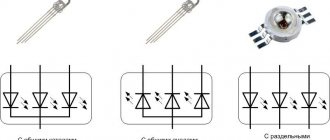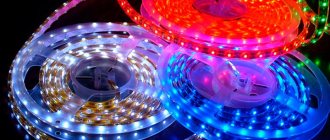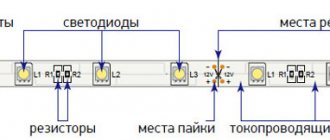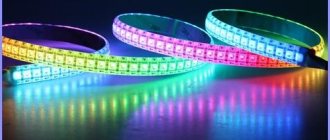An RGB or RGBW LED strip is a lighting device consisting of several monochrome LEDs glowing in white, red, green or blue. It got its name thanks to the last three colors - the first letters of their English translation were taken (Red, Green, Blue - red, green and blue, respectively).
When it is directly connected to a DC source with a voltage of 12/24 V, it is impossible to realize the color effects for which such a tape was created. To provide a variety of colors and brightness, a special controller with a receiver for controlling the remote control (RC) is installed between the power source and the board. This receiver sets various programs according to which the RGB LED strip operates.
RGB technology
Multicolor tape was invented in the course of numerous scientific studies in which scientists tried to create a white glow from LEDs. Initially, blue phosphor diodes with a special white coating were used to produce it. Later, for these purposes, they began to use a strip with three LEDs - red, green and blue. All three are installed in one cell, and the emitted light is perceived by humans as white - this is RGBW technology.
By changing the brightness of a particular LED, you can get other colors and their shades. The number of the latter exceeds several hundred thousand. This is the main advantage of RGB technology over phosphor LED strips.
RGBW and RGBWW LED strips
To achieve better quality of white color with colored LED strips, in addition to three-color LEDs, additional white LEDs were installed on the strips, which were controlled via a separate channel. Such LED strips are labeled as RGBW. The white LED in such strips has a color temperature of about 6000K. Moreover, it remains possible to turn on white light by combining all colors or using a separate channel of white LEDs.
White LEDs can be installed alternately with RGB LEDs, but to achieve better quality, most often such strips have two rows of LEDs, one RGB, the other 5050 white LEDs. Recently, new LEDs have increasingly begun to be installed on RGBW strips, on which, in addition to three color crystals There is also a white LED crystal.
But they didn’t stop there, and added another LED with warm white light with a color temperature within 2900K. This LED strip is labeled RGBWW. The simplest implementation method is to install, in addition to a separate cold white LED, another warm white LED. Nowadays there are even combination white LEDs that can emit both white and warm white light, and combination LEDs with five crystals.
The use of white and warm white LEDs allows you to more accurately set the required shade of white light, and also obtain greater brightness.











